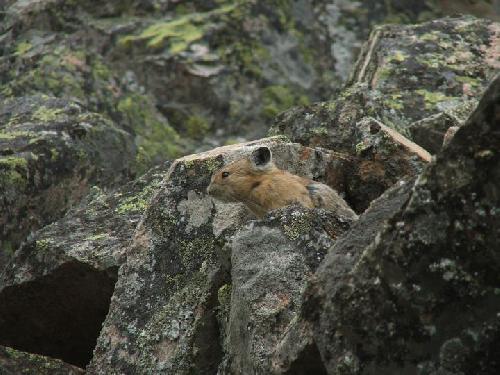CORVALLIS, Ore. - The American pika is thought by many biologists to be a prime candidate for extirpation as the planet continues to warm, done in by temperatures too severe for this small mammal native to cold climates.
But a new study, published this week in the journal Global Change Biology, paints a different, more complex future for this rock-dwelling little lagomorph - the same order that includes rabbits and hares. Pikas may survive, even thrive, in some areas, the researchers say, while facing extirpation in others.
The research is important because pikas are considered a sentinel species for climate change impacts.
 This is a pika. Credit: Clinton Epps
This is a pika. Credit: Clinton Epps
Led by Oregon State University post-doctoral researcher Donelle Schwalm, the study delved into where pikas live and how they move among habitat patches. The team used that information to create species distribution models for eight National Park Service areas in the western United States and forecast pika distribution 30, 60 and 90 years into the future, based on expected climate change scenarios.
The Pikas in Peril research project, funded by the National Park Service, was launched in 2010 to determine how vulnerable the animals are to climate change in eight NPS units.
"If you look at the overall picture, the amount of suitable habitat will decline and temperatures will warm in most of these National Parks," Schwalm said. "But many of these sites have areas that are colder, higher and sometimes wetter than other areas, and pikas should do quite well there.
"In some parks, risk of extinction will increase," she added. "But in other parks, like Grand Teton and Lassen, their populations should remain stable."
Pikas seek out icy pockets in rock fields or lava flows and live near other pikas in small patches of these cool habitats. One key to their survival appears to be maintaining connectivity among different pika patches, which keeps a satisfactory level of genetic diversity among the broader population and allows for the inevitable downturns in survival due to weather, predation, disease and other factors, noted Clinton Epps, an associate professor in the Department of Fisheries and Wildlife, and co-author on the study.
"If you just have three or four pikas in a given area, that's a pretty small group and at the patch level, they can wink out pretty quickly," said Epps, who studies habitat connectivity for many animal species. "But if you can maintain good connectivity, pikas can disperse from other patches and the overall system remains strong as long as habitat remains generally suitable."
The study found that connectivity influenced where pikas persist in most of the eight parks, and thus must be incorporated in forecasts of future pika populations, the researchers noted.
The ideal habitat for pikas is a high-elevation, cold boulder field with north- and east-facing slopes that is adjacent to similar boulder fields. The herbivorous pikas also need access to high-quality forage, including forbs, grasses, sedges, twigs, moss and lichen, said Thomas Rodhouse, a biologist with the National Park Service.
"The study is important because it suggests that some parks may be more appropriate areas to focus our resources than others," Rodhouse said. "If we look at it on a system-wide basis, the pika should survive. But we can't say that they will be thriving, or even present, at all eight parks down the road."
"We potentially could move pikas from vulnerable areas to locations with suitable habitat," Rodhouse added. "Or we could discuss enhancing habitat and creating more connectivity, though you have to examine whether that is something we should be doing in a National Park. But this study allows us to begin having these strategic discussions."
Study results for the eight National Park Service units suggest that:
- Crater Lake National Park's pikas already occupy the highest-elevation habitat, thus there is no refuge to which pikas may escape. Warming temperatures, particularly in winter, may reduce the insulating snow layer and decrease patch occupancy by 50 to 100 percent;
- Craters of the Moon National Monument is hotter and drier than the other parks and the best habitat is occupied. Although temperature and precipitation may change in this park, it appears that the pika will persist, although at lower numbers;
- Grand Teton National Park has exceptional connectivity among habitat patches, which likely will persist over time. Cool temperatures and increasing precipitation at high elevations make this park an important refuge for the species;
- Great Sand Dunes is a cool, dry park and pika populations may experience slight declines initially, but they also could increase over time as precipitation is projected to increase in the future;
- Lassen Volcanic National Park has pikas well-distributed through the talus boulder fields and lava flows. Strong connectivity suggests pikas will persist under most climate change scenarios;
- Lava Beds National Monument is unusually hot, dry and low in elevation, though the extensive lava flow is good habitat. Climate change modeling in this park was inconclusive, but low genetic diversity and warming suggests that this population is vulnerable;
- Rocky Mountain National Park's low elevations and south-facing slopes are impediments to gene flow. Rising temperatures, especially during the winter, and changing connectivity result in increasing likelihood of pika extirpation by the end of the century;
- Yellowstone National Park also is predicted to see complete extirpation of pikas under most climate change scenarios because of warming and loss of connectivity.
As a sentinel species, pikas may provide a clue to how other animals react to climate change, the researchers note. "They can act as the proverbial canary in the coal mine, but they're also just really cute, charismatic little animals," Schwalm said. "There is a lot of public interest in preserving the pikas."
source: Oregon State University